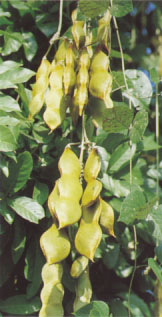
|
|
| Mucuna pruriens - Cowhage - Leguminosae - Tropical and warm zones worldwide |
|
M. pruriens is a leguminous climbing plant, with long, slender branches, alternate, lanceolate leaves on hairy petioles, 6 to 12 inches long, with large, white flowers, growing in clusters of two or three, with a bluish-purple, butterfly-shaped corolla. The pods or legumes, hairy, thick, and leathery, averaging 4 inches long, are shaped like violin sound-holes, and contain four to six seeds. They are of a rich dark brown colour, thickly covered with stiff hairs, about 1/1O inch long. Travellers in the tropics know the plants well on account of their annoying seed-pods, covered with stinging hairs which are easily shaken off, and cause great irritation. They are found in Asia, America, Africa, and the Pacific Islands, cultivated in some parts for the sake of it's golden-brown velvety legumes, which are cooked and eaten as a vegetable when young. Root is useful in diseases of the nervous system, such as facial paralysis, hemiplegia etc. A strong infusion of the root sweetened with honey is given in cholera morbus. Root is also useful for delirium in fevers and when powdered and made into a paste it is applied in dropsy, a piece of the root being also applied to the wrist and ankle. Root is also made into an ointment which is used for elephantiasis. Seed is said to absorb scorpion poison when applied to the part stung. The root is used as diuretic, tonic and stimulant. It is recommended for the nervous system, facial paralysis, hemiplegia, delirium in fevers, and dropsy, in decoction. The infusion of the pods is also good for dropsy. The hairs of the pods are given for threadworms. The seeds are considered astringent, aphrodisiac, tonic, nervine and nutritive. They are given in powder or in decoction in cases of leukorrhea, spermatorrhea, menstrual disorders etc. Mucuna pruriens is reported in Plants of the Gods (Hofmann & Shultes) to contain tryptamine alkaloids, specifically 5MeoDMT, Dimethyltryptamine and related alkaloids, in all parts of the plant. Also reported to contain L-dopa in seeds, a dopamine precursor utilised in parkinsons disease.
TRADITIONAL PREPARATION: In Ayurveda, seeds are prescribed in the form of powder in doses of 20 to 40 grains in leucorrhea, spermatorrhea etc, and in cases requiring aphrodisiac action. A compound powder made of these seeds, and of the fruits of Tribulus terrestris taken in equal parts is recommended to be administered in doses of 1 drachm with sugar and tepid milk, as an aphrodisiac - (Susruta). Another Ayurvedic preparation (known as Vanari Vatika Boluses) is recommended in Bhava - prakash. It is made by boiling 32 tolas of the seeds in 4 seers of cow's milk till the milk becomes thick; seeds are then decorticated and pounded, then fried in ghee and made into a confection with double their weight in sugar. The mass is then divided into balls which are kept steeped in honey. Dose is about a tola. This is reportedly one of the best aphrodisiacs. TRADITIONAL AYURVEDIC PRESCRIPTIONS: 1 - Take of Cowhage seeds 3, Tribulus terrestris 5, Poppy capsules 4, Hygrophila spinosa 3, Bombax malabaricum 3, Ochrocarpus longifolius 2, Curculigo orchioides and Asparagus adscendens 2, and sugar 2 parts. Mix and make a powder. Dose - 15 grains in milk for seminal weakness. 2 - Take of Cowhage, Mace, Camphor, Argyreia speciosa, Acorus calamus and sugar, all in equal parts. Mix and make a powder. Dose - 10 grains, useful in general debility. 3 - Take of Cowhage, Plumbago zeylanica white, dry ginger, long pepper, root of long pepper, mastiche, Cinnamomum cassia and cloves. Mix and make a pill mass. Used in colic, dyspepsia, worms etc. |
|
| Related
Articles : |
|
| Email
This Article To A Friend - Print
This Article Articles can be E-mailed to a friend and you can get a printable version of the article IMPORTANT: We provide all information for educational purposes only, and endorse or recommend nothing here. A special thanks to Keith for all his support and insight. |
|
